After a season playing in the Discover Central Division, the Tampa Bay Lightning are returning back to the Atlantic Division for 2021-22. While it may have only been a year break since the last time they competed against the Atlantic, a lot has happened to their rival teams over the last 18 months. So, let’s take a look and see how the Lightning stack up against the competition.
Sabres, Red Wings, and Senators Want to Take Next Step
The first group of teams to discuss are the Buffalo Sabres, Detroit Red Wings, and the Ottawa Senators, who were all deep in a rebuild when the Lightning last saw them in the Atlantic Division. While all of these franchises have taken significant steps in their process, they also have the most questions about how their young players will handle a full NHL season.
First are the Sabres, who appear to be committed to a new rebuild due to the uncertainty surrounding star centerman Jack Eichel. To put it simply, it’s difficult to project Buffalo competing for a playoff spot without Eichel as their Number 1 center. Stranger things have happened, of course, but with their current roster, the team might still be rebuilding rather than looking to push for the postseason in 2021-22.

The same can be said about the Red Wings, whom the Lightning saw plenty of throughout the 2020-21 season. While Detroit’s roster has been improving over the last few seasons as the fruits of the rebuild initiated by Steve Yzerman start to pay off, the franchise still has a lot of uncertainty surrounding key positions.
However, if newly acquired goaltender Alex Nedeljkovic can come in and lock down a starting role with Detroit, that could push them from a bottom-tier rebuilding team to a true postseason threat. Stable goaltending goes a long way for a young core, after all, and you should never put it past a squad assembled by Yzerman to go on an unexpected run.
Senators Seem Primed To Breakout
Of the three teams who were rebuilding when the Lightning last played them, the Senators appeared to have the most upwards momentum at the end of the 2020-21 season. While the team had a dismal 5-14-1 start, they finished strong, posting a 23-28-5 record.
You may also like:
- Lightning’s Brayden Point’s Elite Shooting Percentage Is Sustainable
- 4 Things Patrick Roy Can Learn From Jon Cooper & Mike Sullivan
- Lightning Should Bring Back Tyler Johnson
- Revisiting the Tampa Bay Lightning’s 2019 Free Agency Class
- Lightning’s Busy Offseason Bolsters Organizational Depth
While you can argue that part of this surge was from playing for a weaker Scotia North Division, you also can’t overlook the strides that Ottawa’s young core took. The team has solid depth on both offense and defense, and if they can get consistent play from Matt Murray in net, they could be that unexpected team in the postseason hunt come March. So, even if they don’t quite reach contention, it also wouldn’t be a surprise if they weren’t selling at the trade deadline for the first time in years.
Canadiens and Panthers Will Fight For Postseason Revenge
The next group of teams the Lightning will be facing in the Atlantic Division were part of their path to the 2021 Stanley Cup. En route to winning back-to-back Cups, Tampa Bay eliminated both the Florida Panthers and Montreal Canadiens, who were experiencing stellar seasons prior to their meeting.
Both of these teams are looking to continue the success that they experienced despite having some turnover in key positions this offseason. For the Panthers, the potential biggest loss happened when Chris Driedger was claimed by the Seattle Kraken in the expansion draft. While Florida felt that he was expendable with their tandem of Spencer Knight and Sergei Bobrovsky, Driedger was an important part of their regular-season success that helped carry the team back to the playoffs.
For Montreal, their major losses include Phillip Danault to free agency, Jesperi Kotkaniemi to an offer sheet, and potentially captain Shea Weber to a career-threatening injury. While their forward corp should be strong enough to rebound from those departures, replacing Weber’s play on the blue line won’t be easy, as he averaged the second-most ice time for the team last season.

Despite these losses, however, neither the Panthers nor the Canadiens can be overlooked. Both teams still have strong rosters that will benefit their recent success on the ice, and they will be adding new young talent that can have an immediate impact on their lineup.
Maple Leafs and Bruins Should Compete For Divisional Title
The final two teams are the Toronto Maple Leafs and Boston Bruins, who were competing with the Lightning for the Atlantic Division title back in 2020. Since they last played each other, however, both of these franchises have experienced some significant turnover, which makes their future a little less certain.
For the Bruins, this includes the departure of Zdeno Chara and Tory Krug in 2020, David Krejci in 2021, and a long-term injury to netminder Tuukka Rask. This has caused them to rely on new faces all over their lineup, most notably the signing of Linus Ullmark, who was a solid netminder for the Sabres but has dealt with injury issues as well.
When it comes to discussing the Maple Leafs, you have to separate what happened in the 2021 postseason from what they could do in the regular season. It would be easy to write the entire team off after experiencing yet another collapse, but this is a roster that should still win a lot of games, even with the departure of players like Zach Hyman and Frederik Andersen.

Perhaps the best way to look at both Boston and Toronto is to acknowledge the talent that they still have. For the Bruins, they still have Brad Marchand, Patrice Bergeron, and David Pasternak on their top-line, where the Maple Leafs still have Auston Matthews, Mitch Marner, William Nylander, and John Tavares in their top-six. As long as those core players continue to be productive, it shouldn’t surprise anyone if either team wins the Atlantic Division in 2021-22.
Predicting The Atlantic Division Outcome
As we take in some of this basic information about the Atlantic Division, four distinct tiers form. They are as follows:
Tier 1: The Pre-Season Favorites
- Tampa Bay Lightning
- Florida Panthers
- Toronto Maple Leafs
Tier 2: Likely to Regress But Still Fight for the Wild Card
- Boston Bruins
- Montreal Canadiens
Tier 3: Should Overachieve But Not Reach the Playoffs
- Detroit Red Wings
- Ottawa Senators
Tier 4: Buffalo Sabres
- Buffalo Sabres
Of course, whenever you attempt to put teams into rankings you will always look like a fool, but let me try to explain why I have these teams where I have them at. Tier 4 is simple, unfortunately. Without Eichel on the ice and with uncertainty on their roster, it’s difficult to expect the Sabres to finish anything above last place in this tough division.
Tier 3 is where I expect a surprise to happen. While I won’t be so bold as to call either the Red Wings or Senators a playoff contender, they have the young talent in place to make a sudden jump up the standings. All they need is steady goaltending play and either franchise could have an outside shot at pushing their way into the postseason discussion.
Tier 2 is a bit more complicated. While I expect both the Bruins and Canadiens to be competitive this season, I find it difficult to expect them to be a lock for the playoffs with the uncertainty on their roster. For Boston, this comes from their often-injured goaltending that lacks a certain start long-term starter right now.

For Montreal, the situation is a little more complicated. Teams that come up short in the Stanley Cup Playoffs often struggle to find their footing the next season, especially when it was an unexpected run like the Canadiens went on. If they still had a healthy Shea Weber and Carey Price, I would feel better about them being in the top three, but with everything in mind, I could see them struggling the first few weeks of the season and having to play catchup for the rest of their schedule.
Finally, Tier 1 comes down to consistency. While the Lightning, Panthers, and Maple Leafs all lost important players this offseason, they still have cores in place that should allow them to cover up these shortcomings. They have strong forward corps that will put up a lot of points, solid defensive units that should continue to improve with new faces added to the lineup, and goaltending tandems that have the potential to be towards the top in the league.
What this Means for the Lightning
As the Lightning look to defend their back-to-back Stanley Cup victories, they will have a tough challenge in front of them with the Atlantic Division. Unlike in years past when there were multiple teams clearly in the rebuilding process, this season there really is only one franchise that should fill this role, the Sabres.
Once you get past Buffalo, however, the rest of the Atlantic Division has done a lot to improve their rosters. In many cases, the teams are deeper than the ones Tampa Bay last faced 18 months ago. There won’t be those stretches of easy divisional games to pad your schedule with this season, and the Lightning will need to start out strong from day one if they want to win the division.

Despite all of this, I still feel that the Lightning should be at the top of the Atlantic Division once again despite the many challenges they faced throughout the offseason. However, hockey is a beautiful, chaotic sport, and trying to predict what can happen is impossible, so Tampa Bay can’t take anything for granted during the 2021-22 season.